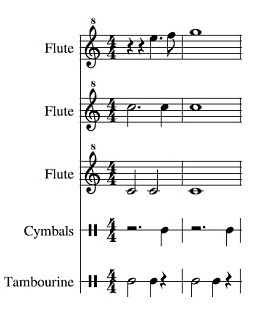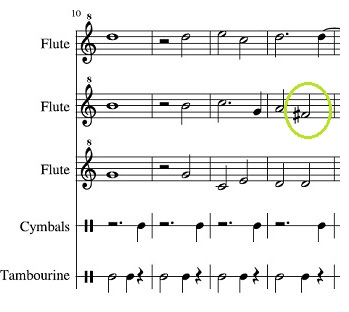"Solfeggio"
Time signature: 4/4
The bar that is used in these scores is 4/4. As we saw in the previous unit, the numerator indicates number of beats ( 4), whereas the denominator indicates the note.
In this score it is 4 (the quarter note is the note that indicates the beat).
So, the bar 4/4 means that in each bar there are 4 quarter notes.
Check in these scores! 
In order to read any score, you must remember that 4/4 is done like this:
Accidentals
Do you remember the accidentals? They are signs that modify the height of the notes.
There are 3 different types (listen to the audios to understand it better):
- Sharp (#): it raises the sound half tone.
- Flat (b): it lowers the sound half tone.
- Natural sign (
): it nullifies the sharp and the flat.
There are different types of accidentals:
- Key Signature: they appear at the beginning of the song, between the clef and the bar, and they affect the whole score.
- Accidentals: they appear in the middle of the score and they only affect the note they precede and all the rest that are the same and are located in the same bar.
In the Renaissance score there is one of them, do you know how it is called?

About time signature and accidentals
Read the paragraph below and fill in the missing words.
The tie and the slur
As its name indicates, it is a musical sign that is used to join two or more sounds. There are two types:
- Tie: it joins two equal sounds.
- Slur: it joins two or more different sounds, and it is used to avoid the musical phrases to be cut.
The ones that appear in Middle Age and Renaissance scores are ties, and they allow a sound to be joined to another with the same name and height.
Do you know how to do it?

True-False Question
Listen to the audios before answering:
Feedback
False
Feedback
True
Feedback
True
Feedback
False
It is a slur.
Feedback
False
Feedback
True
Feedback
True
Licensed under the Creative Commons Attribution Non-commercial Share Alike License 4.0